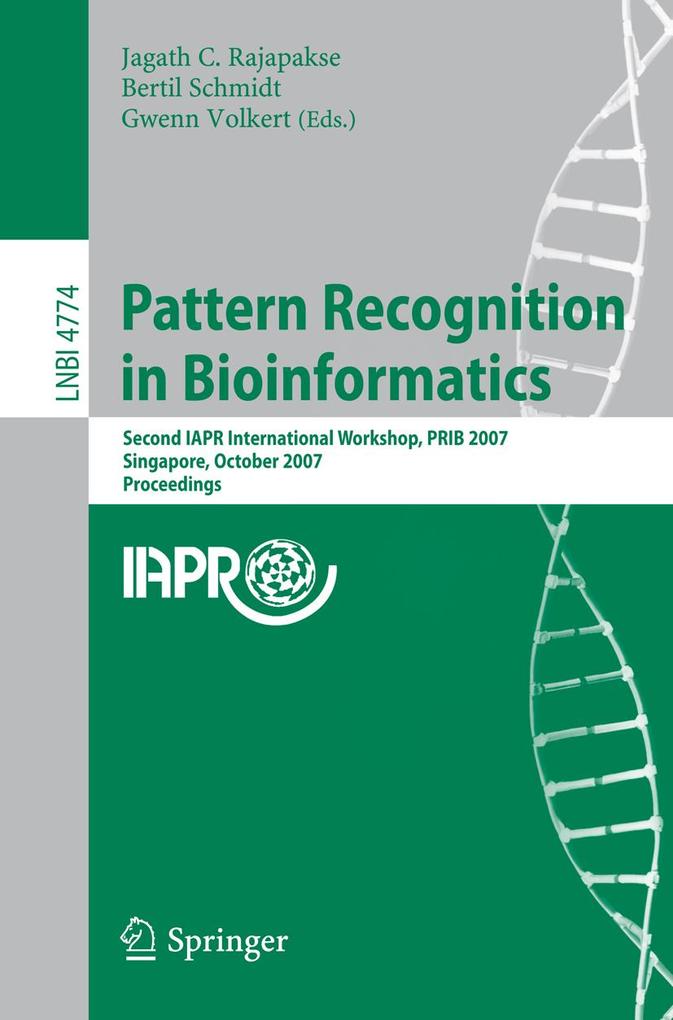
Sofort lieferbar (Download)
The advancements of computational and informational techniques have enabled in silico testing of many lab-based experiments in life sciences before performing them in in vitro or in vivo. Though computational techniques are not capable of mimicking all wet-lab experiments, bioinformatics will inevitably play a major role in future medical practice. For example, in the pursuit of new drugs it can reduce the costs and complexity involved in expensive wet-lab experiments. It is expected that by 2010, sequencing of individual genomes will be affordable generating an unprecedented increase of life sciences data, in the form of sequences, expressions, networks, images, literature. Pattern recognition techniques lie at the heart of discovery of new insights into biological knowledge, as the presence of particular patterns or structure is often an indication of its function. The aim of the workshop series Pattern Recognition in Bioinformatics (PRIB) is to bring pattern recognition scientists and life scientists together to promote pattern recognition applications to solve life sciences problems. This volume presents the proceedings of the 2nd IAPR Workshop PRIB 2007 held in Singapore, October 1 2, 2007. It includes 38 technical contributions that were selected by the International Program Committee from 125 submissions. Each of these rigorously reviewed papers was presented orally at the workshop. The proceedings consists of six parts. Part 1: Sequence Analysis; Part 2: Prediction of Protein Structure, Interaction, and Localization; Part 3: Gene Expression Analysis; Part 4: Pathway Analysis; Part 5: Medical Informatics; and Part 6: Bioimaging.
Inhaltsverzeichnis
Sequence Analysis. - Automated Methods of Predicting the Function of Biological Sequences Using GO and Rough Set. - C-Based Design Methodology for FPGA Implementation of ClustalW MSA. - A Two-Phase ANN Method for Genome-Wide Detection of Hormone Response Elements. - An Expert Knowledge-Guided Mutation Operator for Genome-Wide Genetic Analysis Using Genetic Programming. - cDNA-Derived Amino Acid Sequence from Rat Brain A2aR Possesses Conserved Motifs PMNYM of TM 5 Domain, Which May Be Involved in Dimerization of A2aR. - Strong GC and AT Skew Correlation in Chicken Genome. - Comparative Analysis of a Hierarchical Bayesian Method for Quantitative Trait Loci Analysis for the Arabidopsis Thaliana. - Prediction of Protein Structure, Interaction and Localization. - Using Decision Templates to Predict Subcellular Localization of Protein. - Generalized Schemata Theorem Incorporating Twin Removal for Protein Structure Prediction. - Using Fuzzy Support Vector Machine Network to Predict Low Homology ProteinStructural Classes. - SVM-BetaPred: Prediction of Right-Handed ß-Helix Fold from Protein Sequence Using SVM. - Protein Fold Recognition Based Upon the Amino Acid Occurrence. - Using Efficient RBF Network to Identify Interface Residues Based on PSSM Profiles and Biochemical Properties. - Dynamic Outlier Exclusion Training Algorithm for Sequence Based Predictions in Proteins Using Neural Network. - Bioinformatics on ? -Barrel Membrane Proteins: Sequence and Structural Analysis, Discrimination and Prediction. - Estimation of Evolutionary Average Hydrophobicity Profile from a Family of Protein Sequences. - Gene Expression Analysis. - APMA Database for Affymetrix Target Sequences Mapping, Quality Assessment and Expression Data Mining. - Ensemble of Dissimilarity Based Classifiers for Cancerous Samples Classification. - Gene Expression Analysis of Leukemia Samples Using Visual Interpretation of Small Ensembles: A Case Study. - Ant-MST: An Ant-Based Minimum Spanning Tree for Gene Expression Data Clustering. - Integrating Gene Expression Data from Microarrays Using the Self-Organising Map and the Gene Ontology. - Order Preserving Clustering by Finding Frequent Orders in Gene Expression Data. - Correlation-Based Relevancy and Redundancy Measures for Efficient Gene Selection. - SVM-RFE with Relevancy and Redundancy Criteria for Gene Selection. - In Silico Expression Profiles of Human Endogenous Retroviruses. - Pathway Analysis. - A Framework for Path Analysis in Gene Regulatory Networks. - Transcriptional Gene Regulatory Network Reconstruction Through Cross Platform Gene Network Fusion. - Reconstruction of Protein-Protein Interaction Pathways by Mining Subject-Verb-Objects Intermediates. - Validation of Gene Regulatory Networks from Protein-Protein Interaction Data: Application to Cell-Cycle Regulation. - Medical Informatics. - Rough Sets and Fuzzy Sets Theory Applied to the Sequential Medical Diagnosis. - In silico Identification of Putative Drug Targets in Pseudomonas aeruginosa Through MetabolicPathway Analysis. - Understanding Prediction Systems for HLA-Binding Peptides and T-Cell Epitope Identification. - Predicting Binding Peptides with Simultaneous Optimization of Entropy and Evolutionary Distance. - Bioimaging. - 3D Automated Nuclear Morphometric Analysis Using Active Meshes. - Time-Frequency Method Based Activation Detection in Functional MRI Time-Series. - High Performance Classification of Two Imagery Tasks in the Cue-Based Brain Computer Interface. - Human Brain Anatomical Connectivity Analysis Using Sequential Sampling and Resampling. - Classification of CT Brain Images of Head Trauma.
Produktdetails
Erscheinungsdatum
19. September 2007
Sprache
englisch
Seitenanzahl
410
Dateigröße
19,31 MB
Reihe
Lecture Notes in Computer Science
Herausgegeben von
Jagath C. Rajapakse, Bertil Schmidt, Gwenn Volkert
Verlag/Hersteller
Kopierschutz
mit Wasserzeichen versehen
Produktart
EBOOK
Dateiformat
PDF
ISBN
9783540752868
Entdecken Sie mehr
Bewertungen
0 Bewertungen
Es wurden noch keine Bewertungen abgegeben. Schreiben Sie die erste Bewertung zu "Pattern Recognition in Bioinformatics" und helfen Sie damit anderen bei der Kaufentscheidung.










